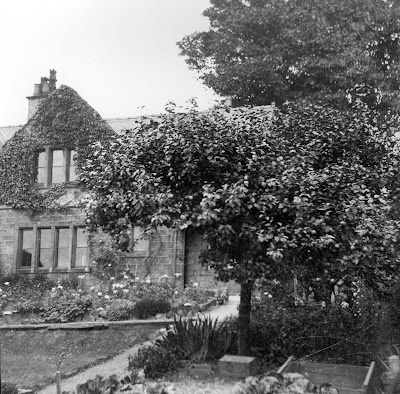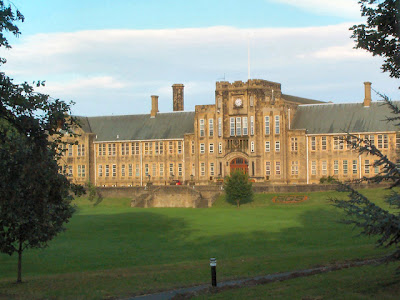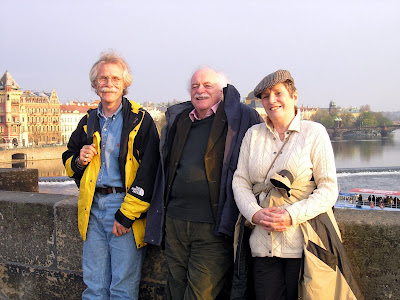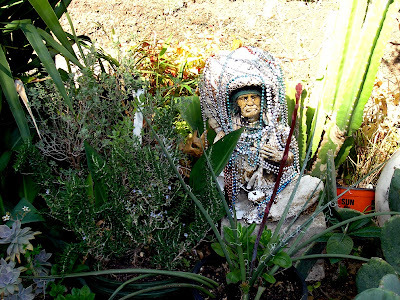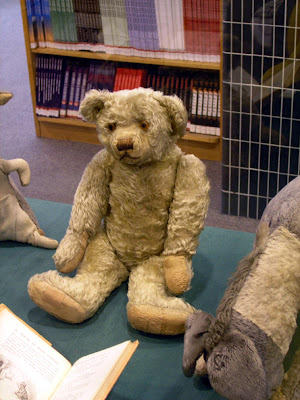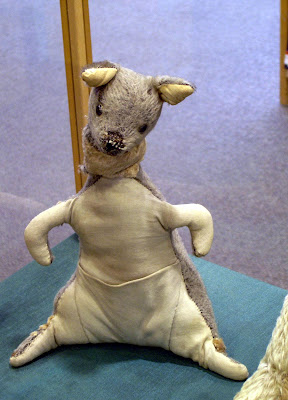I spent less than one third of my life in Riddlesden but would be horrified to be thought of as anything but a Yorkshire lad. I even relish the fact that I was actually born in Micklethwaite and what better name for a village could there possibly be? Back in the 50s, my parents bought our house on Ilkley Road for £500. They had already been renting it for a dozen years or so from a Mr. Spencer who lived at “Four Winds”, some way up the road. This is the house in its prime:
A typical English semi, the house was built in about 1908, looked rather grand from the outside and had a magnificent view of the Aire Valley.
Looking to the southwest from my mother’s bedroom you could even see way over the Worth Valley and across to Brontë country. In the far distance were the Pennine moors that separated us from Lancashire. Our huge garden had wonderful trees in it. At least three of them were very climbable and I spent many happy hours up the Prune Plum, the Bramley and the Victoria Plum.
Inside the house it was a different story with a permanently damp kitchen, rather poky rooms and a ferociously steep staircase. The primary source of heat was a coal fire in the only decent-sized living room. How I hated getting the coal and raking those ashes. However, my mother’s tasks were often worse; she occasionally had to black the fireplace with some un-Godly grate polish, probably lead or graphite-based and probably toxic.
Even more challenging for her was the weekly laundry, boiled in a huge gas-fired copper out in the “wash-house”, squeezed half-dry in a hand mangle and then hung out on the long washing-line. No washer or dryer, spin or otherwise. Bedrooms were unquestionably frigid in the winter though we usually had a small electric fire to go to bed by. But the bedclothes were plentiful and toasty and how else could you make peepholes in the morning with warmed pennies melting the ice on the inside of the windows?
I have three siblings, this is all four of us: Basil, Biddy, William and baby Freddy (now aka Spencer). Circa January 1956.
And this one Biddy and me, circa 1952. The log was a favorite plaything of all of us and came from the huge sycamores which grew on the bank across Ilkley Road opposite no. 22. The trees were cut down during the war, presumably for fuel.
After my elder brother and sister left home for university, I commandeered the only other downstairs room (which we called the “study”) for my museum. What a nerd I must have been …. but it was featured in the “Keighley News” complete with the Duck-billed Platypus, numerous rocks & fossils, a Victorian Drum & Bells Music box and an assortment of ethnic paraphernalia from my father’s trips to the Middle East.
In those days, even the youngest of children truly did have adventures. Do they today? As a very small boy I would pedal around on my painfully-slow tractor with Phil Pickles from next door (on his far superior tricycle) or with Steve Ickringill from three doors up. This is Phil on the tractor seat with me on the “bonnet”.
Phil recently reminded me of the momentous occasion when I took his blue tricycle (with or without permission, I wonder?) and rocketed down their very steep garden path only to collide ignominiously with their solid and unforgiving water-butt which stood next to the garage. I still have vague memories of Mrs. Pickles yelling “use the brake” while observing my ill-advised descent. Alas, to no avail.
This classic photo shows Phil Pickles’ birthday party, circa 1957. Back row, L > R: Phil Pickles, Steve Ickringill, ???. Middle row, l > R: John Wilkes, William Hudson, ???. Front row L > R: Andrew Blackwell, John Blackwell.
As I grew older I would roam further afield. I was taught to fly kites at East Riddlesden Hall (which dates from the 1600s) by Chris Hope from Hospital Road It was from here that we also explored the River Aire and I learnt about snakes, tadpoles and voles from Timothy Holdsworth of Barley Cote.
We would walk though the fields to Benson’s, climb Rivock Edge or trespass in the old Isolation Hospital where Hospital Road meets Carr Lane. All of these places were several miles from home and I cannot remember my mother being particularly worried about my whereabouts at any time of the day.
The summers seemed interminably warm and the days were long. How it used to frustrate me when my mother called bedtime while my brother & sister were still playing rounders with older friends on the lawn. In those years when it was really hot, the tar in the road would melt so we could daub our initials on the pavement edge stones. I wonder if mine are still there.
In the winter we would often be out well after dark. But it was then that the most fun was to be had. After a good snowfall we could sledge down Unity Street at breakneck speeds, crashing over the bumps we had built, swerving at the bottom to avoid smashing into Mr. Ackroyd’s stone wall and finally slowing to a stop somewhere down Johnny’s Hill, more correctly known as St. Mary’s Road.
It seems as though the every child in the village would congregate on the street on those crisp, clear nights. Each of us was convinced that our sledge was the fastest.
The other season I remember well was Bonfire Night (Guy Fawkes) when a huge bonfire would be lit at the vacant lot at the bottom of Unity Street together with the requisite “Guy” who was consumed by the flames. Rather a macabre tradition really but the village lads had fun for the few weeks before November 5th “progging” or collecting wood & branches for the bonfire. Accompanying the fire were potatoes baked in the embers, plot toffee and parkin. All delicious stuff!
Our neighbors on Ilkley Road were the Pickles and the Storks on each side, the Harrisons (then Hardacres, then Drivers) next to the Storks and the Ickringills and Midgleys further up the road. Phil also recently reminded me of the telephone party-line between us and the Pickles house. Our mothers used to knock on the dividing wall at the back of the cupboard in the living room if they wanted to gossip without paying for the call.
Adjacent to us was Unity Street with its magnificent Yorkshire stone terracing clinging to the cobbled hill with its 20% grade. The Langhorns, Scotts, Slaters, Gaunts, Barretts, Dawsons and yet more Midgleys were all families who lived there. This is Shirley Gaunt’s wedding (on the right) with her bridesmaid-sister, Audrey.
Who knows, perhaps some of them are still around. It was Mr. Dawson who delivered fresh eggs to our house every week from his hens that he kept on the allotments, now long built-over. And of course Mrs. Harker lived at #31 Unity Street. She was the epitome of faded gentility who was rather like a great-aunt to me and my siblings during our childhood years. Sadly, my mother later had some quarrel with her and so our relationship with this kindly soul faded away.
The village was a mix of housing; terraces, cottages, semi-detacheds and farm-houses. Unity Street, as its name suggests, was a Co-op social housing scheme and the semis on Ilkley Road were known as the "Co-op Villas". Opposite Bowmans’ shop, just up the road from “The Willow Tree”, there was even a short terrace of back-to-back houses that had no indoor toilets. There were two or three shared out-houses at the bottom of the cobbled street with its sandstone-flagged pavement. I am sure that they have been outlawed by now but there cannot have been much room for the requisite indoor bathrooms. It was next to the “Willow” that the old single-decker bus from Keighley used to turn around, long before it extended its route to Barley Cote. The current route now includes Dunkirk Rise which would have been way too steep for the old Number 13 buses of my early days. This is a half-cab single decker bus from the 1950s and similar to the #13 that I remember. Of course they would have been red.
My mother ordered our groceries from either Hudsons (no relation) in Keighley or from Bowman’s. Meat was delivered from the butcher on Bar Lane and milk came from Michael Holmes’ farm at Elam Grange. When I was very young, it came from Cravens farm near Barley Cote and was delivered from jug to jug. On odd occasions when we ran out of milk, we would walk up to the farm for that extra jug-full.
Jack Hiley was the local door-to-door greengrocer who was considered very modern with his motorized van. In earlier days he had a horse-drawn cart but as far back as I can remember, it had already been sold and was used by the two local street sweepers. But you could still see the name Jack Hiley painted on the side of the cart. Every once in a while the Rag & Bone man would wander around with his own characteristic cry, almost unintelligible unless you knew who it was. And then there were the Kleeneze and Betterware reps. selling brushes, shoe polish and dusters from their battered suitcases. And, as they usually had a small freebie for me, I was always pleased to see them.
Some years ago, on one of the rare occasions when I was back in Riddlesden, I was taking a photo of Unity Street and a woman got out of her car to talk to me. We immediately recognized each other as someone we each knew; at least she realized I was of the Hudsons. It was Joan Sunderland who said that her mother used to “do” for mine. The quote from her mother that Joan remembered most was “that Basil Hudson, he’s a right little bugger”. My sister says that Joan’s dad used to help out in our garden but that’s beyond the range of my memory.
My first school was Rossfield in Bingley which I went to in about 1952. I have very few memories of it other than only being allowed one drum stick if I was to play in the band and being given my mug and pencil for the 1953 coronation. I was not yet five. The last time I was there I could not even recognize the school building so I made do with a very tolerable pint of Timothy Taylor’s and a Yorkshire pudding at the Brown Cow.
On that same trip, Banks Lane next to St. Mary’s school in Riddlesden, where I went about 1953 or 54, was temporarily closed to traffic because a gigantic crane was lifting pre-fabricated school buildings and swinging them over the houses and trees into the school yard at the back. Ironically, this was all taking place one year before the school was finally closed and incorporated with Grange School. The end of a one hundred and fifty year era. Mr. Hooper was headmaster in my day but I never really knew him. As an “infant”, my formative Riddlesden school years were spent under the tutelage of Miss Walker, Miss Albert and Miss Thompson, all of whom were good souls and who did, I believe make creditable teachers.
There was one other woman who was rather more sinister and who should never have been a teacher of young children in the first place. Perhaps her name is best forgotten. These pictures are from the class photo taken around 1957. Two classes were combined for the photo. Mr Hooper is there but the other teacher shown was a temporatary whose name escaped me:
I remember the time I go my knuckles rapped with a ruler by Miss Thompson. My crime? Peeking over the girls’ toilet wall. I was only six however, so we may be charitable and put it down to normal developmental curiosity. I also remember Mr. Lumby furtively crossing the playground after school to visit Miss Thompson in her classroom. So it was no real surprise when they became engaged! Some years later, Mrs. Lumby as she became, was recruited by my obviously apprehensive parents to coach me for that most infamous of exams, the 11-plus. She clearly did an excellent job because I passed and for that I shall always be grateful to her. I think that this photo was taken in my last year at Riddlesden.
My mother came from several generations of atheist though my father, probably an agnostic, was brought up in a typically Victorian Church of England household. We had no religious component to our own family life so my mother was somewhat nonplussed to hear that I wanted to join the choir. However, my motives were more social than spiritual because several of my village friends were in the choir and relished (or so they thought) being the subject of admiration from the young girls who giggled on the back pews. An earnest young man called Mr. Scott was the choirmaster, Keith Chisholm was the head choirboy and my friend Les Holmes (“Ozzer”) was his deputy. This is Les and me, circa 1959.
Other members included the Beadman twins (Nigel & Paul), the Elvis brothers (Richard & Tony), the Gee brothers (Michael and Chris), Chris Hope, Phil Pickles and Ian Graham.
This photo shows from L>R: Chris Gee, me, Keith Chisholm, Groom & Bride, Les Holmes, David Smith and Tony Elvis.
Each year we were rewarded for our musical endeavors by our annual day’s outing, usually to either Morecombe or Blackpool. It always bothered the vicar (who was, rather appropriately, called Mr. Bishop) that he had a choirboy that had not even been baptized but I was there for purely secular reasons.
But did these childhood fancies ever blossom into romance? Alas no. I did have a crush on Margaret Gee from the age of about six to eleven. She is probably unaware of that to this day. Her competition for my heart at the time was one Jane Sheard, also blissfully ignorant of my infantile yet amorous yearnings. Some years later, at the ripe old age of fourteen or so, I was smitten by Barbara Taylor, the daughter of Keighley’s chief librarian. As her brother went to the same grammar school as I did, he was able to play the role of Go-Between. Eventually, I did pluck up enough courage to ask Barbara to go canoeing with me on the Leeds-Liverpool canal. How risqué can things get?
I was not at St. Mary’s school very long because in 1957 I was accepted into the Junior School of Bradford Grammar School (BGS). The school was founded in 1548 but the current building completed in 1939.
And so I then became a member of the 67 Club, the number of the red double-decker bus that picked us up every day from Granby Lane. But those days are part of another tale. As I got older, though I still lived in Riddlesden, many of my earlier ties grew weaker. Many of my friends from St. Mary’s went to other schools and our paths diverged, especially after my choirboy days were over. There were exceptions, Phil Pickles also went to BGS and he and I still email one another from time to time. I stayed the best of friends with Steve Ickringill. He and his wife Jane still remain very close to Sharon and me even though we now live on different continents. This is Steve around 1960.
Sharon, Jane and Steve in Prague in 2004:
And me, Steve and Jane on the same trip.
That last visit of mine brought back many happy memories but inevitably had its moments of sadness. Most of the semis on Ilkley Road and on the lane below are getting distinctly tatty with cracking pebble-dash, rotting window frames, slipped roof slates and peeling paint. Our garden no longer exists; the top half is now a patio/conservatory and a mechanical digger has scooped out the lower half as a parking lot. Every single one of the trees are now gone.
In contrast, the supposedly more modest houses on Unity Street look as solid and well-kept as they ever did. I drove up the moors of course. The heather was in full bloom and was quite spectacular.
The springiness of the tufted grass on the peat felt as it always did. The old horse trough (with an 1854 date) just below the “summit” was still there although the one next to Primrose Farm has been nicked. Even this vandalism pales in comparison to the recent ploughing over of the last of the bronze-age stone circle at Bradup. On a more modest note, it was no surprise that there was no sign of the old wooden snow-plough outside nearby Upwood. It must have rotted away years ago.




